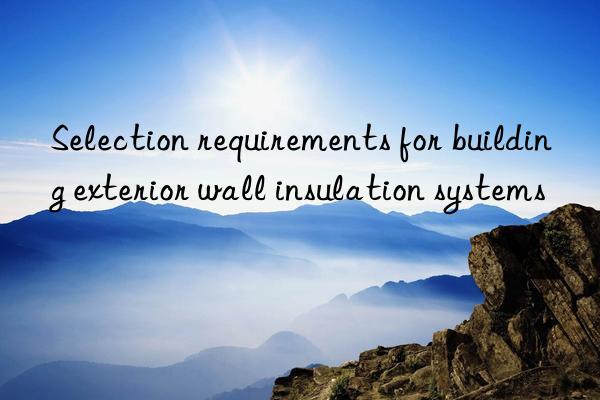
The thermal insulation system can be divided into exterior wall insulation, exterior wall interior insulation and sandwich insulation according to the insulation method. However, according to the use of different insulation materials, several common insulation systems include benzene board thin plaster insulation system, polystyrene particle insulation system system, vitrified microbead insulation system, etc. Different types of insulation systems also have certain differences in performance and functions. How to correctly choose the appropriate building exterior wall insulation system?
1. Selection based on the quality of insulation materials
1. First of all, the energy-saving efficiency of insulation materials should be high. The lower the thermal conductivity value, the thinner the insulation layer thickness under year-on-year conditions, the better the system safety. Such as XPS/EPS boards, polyurethane rigid foam boards, phenolic foam boards, etc., are all high-efficiency and energy-saving materials.
2. Secondly, the thermal stability of the insulation material should be better. Under the action of solar thermal radiation, the surface temperature of the outer insulation layer in summer can reach as high as 60-70°C. In the south, it can even reach as high as 80°C, which is a great thermal challenge for the insulation material. If the heat-resistant stability of the insulation material is insufficient and the insulation material deforms too much, it will inevitably lead to cracking and falling off of the insulation system. Therefore, the foam medium should be reasonably selected according to the high temperature climate characteristics of each region (the critical temperature of thermal stability of several organic foams: molded board EPS ≤ 70 ℃, extruded board XPS ≤ 75 ℃, rigid foam polyurethane PU ≤ 120 ℃, phenolic foam PF ≤ 180℃).
3. When selecting an organic foam board, the surface binding energy of the board should also be considered. The occurrence of cracking and falling accidents in exterior wall insulation projects is largely caused by bonding problems. The surface of pure foam board is smooth and dense (especially XPS board), which is difficult to be compatible with bonding mortar. Without interface treatment, it is easy to cause false adhesion and debonding. In the energy-saving design of high-rise buildings, interface mortar treatment matters should be clearly specified. It is best to use the newly developed composite reinforced panels that have been processed with factory interfaces.
4. In order to consider the fire safety of high-rise buildings, non-combustible and flame-retardant materials should be used as insulation materials. If organic foam is used, thermosetting foam, such as polyurethane foam and phenolic foam, should be used. When other foams are used, fireproof isolation belts should be installed. The relevant departments of this specification are under revision and preparation. In daily design, rock wool boards, polyurethane foam boards or phenolic foam boards can be used for composite insulation, isolation and fire protection around doors and windows and between layers.
2. Selection of energy-saving systems according to different decoration requirements
1. Coating finishing system: Due to the light weight of the coating finishing layer and its continuous closed construction, the requirements for the thermal insulation plastering layer are relatively high. If it is low, you can choose a plate-type thin plastering system. Of course, you should also pay attention to quality safety and fire safety.
2. Porcelain tile facing system: This system is controversial in high-rise buildings. Some provinces and cities restrict its use, and some areas have height restrictions. The main reason is that the outer surface is heavier and there are concerns about insufficient safety performance. If it is to be used, the following conditions should be met: A. The tensile strength of the insulation layer itself is ≥ 150KPa, that is, the tensile strength of the insulation mortar or insulation board is ≥ 150KPa; B. The insulation layer has good adhesion with the wall, and between the insulation layer and the plastering mortar. If the joint strength is ≥150KPa and the effective bonding area with the wall is ≥60%, composite reinforced foam boards should be used; C. In order to reduce the damage caused by the accumulated load, it is advisable to set compartment joints every 2 to 3 layers and use brackets To disperse the force.
3. Dry-hanging curtain wall engineering: non-transparent curtain wall engineering insulation system, it is customary to use filled insulation. This type of project focuses on fire protection issues. Of course, it is best to use thermoplastic foam (EPS/XPS). Effective fire isolation measures must be set up, such as using thermosetting foam, and a protective mortar is applied on the surface of the foam layer.
Finally, we should pay attention to some misunderstandings when choosing building exterior wall insulation systems, such as one-sided pursuit of low cost, emphasis on insulation material selection, neglect of technical system promotion and only focusing on products, and neglect of thermal performance requirements and engineering Quality assurance conditions, etc.
</p

 微信扫一扫打赏
微信扫一扫打赏

